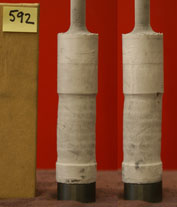
Ice592: 3 x P-drop f.g. ice I + 2.5% by vol 1-micron Al2O3
Preparation mirrors that of 590 (10% al2o3)
| Legend: top graph of each pair is motor speed V (i.e., edot), bottom is load. Top graph is the one to pay attention to. Translate V to edot thus: V0.05 ≈ 3e-8/s (for 10:1 gearing V0.05 ≈ 3e-7/s). Horizontal scale is time. 5000 pts ≈ 14 hrs. | ||
.png) |
e=0.156 | Thurs 1/28 0500 hrs. Step (8). Grain growth at fixed s in the GSS creep field would cause edot to drop. That is happening here but the effect is not very pronounced; barely significant if at all. End of run. |
.png) |
e=0.141 | Step (7). Leveled out at ~4x faster than step(6), for a stress level 1.5x higher, which means n≈4. Not so GSS like, but let's see where it all plots up. |
.png) |
e=0.127 | Weds 1/27 0920 hrs. Step (6). Now back running in creep mode. edot a little slower than expected for GSS, still well faster than GSI. Zero s gage drift; stupid problem gone for sure. Operator's fault for skipping a critical step during initial assembly. |
.png) |
e= 0.120 | Step (5). Things back to normal, maybe, so try a measure of n. Constant disp rate V0.10 is 3.3 x faster than step (4b). s levels off at ~3 MPa, 50% higher than previous step, then mysteriously rises to new level at ~3.2. Doing the math, n = 2.9 to 2.4. So: s gage ~behaving, rheology looks like GSS, grain growth after 72 hrs at 230 K looks mininal. Keep plugging. Next step: down to 210 K to confirm GSS. |
.png) |
e=0.108 | Tues 1/26 0940 hrs. Step (4d). End up running const displ again until confidence in s gage drift returns. Target s = 2 MPa now seems to require only V0.03. In ~46 hrs since start of step (4b) displacement rate to hold s = 2 MPa (±?) has gradually fallen from V0.05 to V0.03 (~3.5 -> 2.1 e-7/s). This is hardening, although barely significant. Strength is pretty much the GSS value in D etal 2001 Fig.2. And good news: s gage drift now ~normal. |
.png) |
e=0.093 | Step (4c). Again running constant disp rate, V0.04 as shown. Downward drift of s gage persists, for this substep amounting to about 0.3 MPa. Stress began at 2.0 MPa, ended at 2.4 MPa. Back in lab after 3-day weekend. Took steps to fix s gage problem. |
.png) |
e=0.091 | Mon 1/25 0615 hrs. End step (4b). S**t. Another bad downward drift of 0.7 MPa in s gage. So the substep began at 1.7 MPa and ended at 2.4 MPa. The whole step (4)started at 1 MPa and is now at 2.4 MPa. |
.png) |
Start of step (4b). s gage problems forcing me to work in constant displacement rate mode, here V0.05 in order to hit general area of target s = 1.7 MPa. | |
.png) |
e=0.066 | Sun 1/24 1130 hrs. End of step (4a). AGAIN force gage zero showed a terrible downward drift of 3 mV (0.8 MPa), meaning that stress at the end of the run had risen to 1.7 MPa, after starting at 1 MPa. When is this guy going to learn how to run the machine?? |
.png) |
e=0.061 | Step (4a) continues a-ok. See that edot has leveled out at V0.04. For 20% drop in stress, change in edot was maybe ~factor of 2, which means n = 3. |
.png) |
e=0.054 | Sat 1/23 ~2130 hrs. Start of step (4a). Now at 230 K, this is indended to be a multiple-day run looking for hints of grain growth at 230 K. If it's GSS creep, then edot should slowly drop at fixed s. Technique had good success at 233 and 243 K in pure f.g ice (D et al, 2001). Turned out initial edot was too high to maintain for several days, so as you can see on the lower chart I cut back s by 20%. |
.png) |
e=0.045 | Fri 1/22, ~1700 hrs. Step (3). s is 50% higher than in step (2). Again zero drift of s gage was significant, about 0.3 MPa, so run started at 3.1 and ended at 3.4 MPa. |
.png) |
Combined information from the images below, all of steps (1) and (2), showing the effect of dropping s by about half. This is a little deceptive; because of the drop in the zero point, the actual percentage change in s could have been significantly less than 50%, meaning n woud be significantly higher than this chart suggests. |
|
.png) |
e=0.025 | Fri 1/22 1115 hrs, step (2). s is 50% lower. Force gage zero at end of step showed a disappointing drift of almost 1 MPa over steps (1) and (2). Can't guess where it happens, but result brings great uncertainty to the value of n. Norminal calculation shows it to be quite high. End of simple story. |
.png) |
e=0.0184 | 2145 hrs, end of step (1). Still tracking ~5 mu grain size pure ice. This immediate attainment of steady-state is characteristic of GSS. At the end of this step, I immediately reduced the stress by a factor of ~2 for a quick measure of n. |
.png) |
e=0.0045 | Thurs 1/21 1615 hrs, just started step (1). Hit a steady level right away at edot ~6e-7/s. This matches pure f.g. ice if it stays here. For comparison, 592 (10% al2o3) leveled out at 2e-8/s, and hit that before e=0.003. We'll see. |